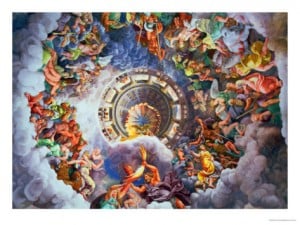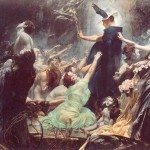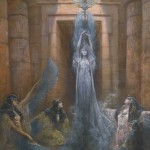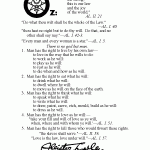 Polytheism is what happens when you know more than one God, or at least that’s how it happened to me. Coming across the Kali image in Ram Dass’s Be Here Now broadened my horizons and sent me looking for more. Of course, I had known of the Greek and Roman gods of the myths, but here was a Goddess, a deity that was not the Yahweh of my parents, that people took seriously. Lifting my head from my cultural furrows, I discovered a whole world of deities. From Kali’s Hindu pantheon I worked my way back West by way of the Norse, the Egyptian, and the Irish by reading their myths. When I began meeting contemporary Pagans, I again found some people who took these many gods seriously.
Polytheism is what happens when you know more than one God, or at least that’s how it happened to me. Coming across the Kali image in Ram Dass’s Be Here Now broadened my horizons and sent me looking for more. Of course, I had known of the Greek and Roman gods of the myths, but here was a Goddess, a deity that was not the Yahweh of my parents, that people took seriously. Lifting my head from my cultural furrows, I discovered a whole world of deities. From Kali’s Hindu pantheon I worked my way back West by way of the Norse, the Egyptian, and the Irish by reading their myths. When I began meeting contemporary Pagans, I again found some people who took these many gods seriously.
Polytheism Now
Polytheism has a place in the world’s future partly because of its broadly inclusive nature. Yet it can not be assured of that place unless those who practice ‘the old ways’ do so openly, usefully, and with vigor. I see the task of today’s polytheists being to reawaken the practices of the old deities to manifest again their presence here. This can be done through embodying the deity in their relevant arena.
As I see that the first task of the priestcraft is to bless, I feel that all those who have the power of making present the presence of a deity should do so on all appropriate occasions so that the deity’s nature may be widely experienced, and so its power may be of good effect again in the world of humankind. For example, whenever people travel, I bless them in the name of Hermes Mercurius, that He may watch over them in their travels. This would spread deity’s fame and thus strengthen Their presence here.
The second task would then be to rebuild the worship of those deities. For example, it was ancient custom in Greece to make offerings of smoked meats, cakes, and drink, to Hermes and Hekate on the night of the dark of the moon at the herms, the square based knob topped roadmarks, and at the triangularly based heketerions at the places where three roads meet. These simple things can make the power of the deities present and effective in one’s life, and in the world.
Contrast this with monotheism, which has a distinct disability in its often not-so-subtle mono-‘thesis’ism. With its stress on the Sole God, it asserts that there is only one correct idea about that god and its worship and thus what life means. Islam and Christianity, to name the two largest monotheistic traditions, are famous for their rigid attitudes and violent proselytization.
Polytheism on the other hand speaks to a kind of openness in its very structure that welcomes a plurality of ‘theses’. As each deity presents a different approach to life, any one or more of which could be suitable to any person. Working with Hermes as ‘Lord of Information’ helps me navigate in our emerging information culture. The openness of a pantheon makes for an openness in dealing with people whose character is radically differently than one’s own. One just expands the pantheon to accommodate the new deity. This is a power we need in our highly pluralistic age. It would permit us to truly sit down at the same table to live and to worship.
Classifying the Deities
Not all deities are experienced in the same way. I have found it useful to classify deities into a few broad but hardly exhaustive categories. This was necessary as different types of deities required different kinds of handling and provided different benefits and insights.
Nature Principles
For instance, the Ancient Egyptians saw their deities, called the Netcheru, as the principles of nature given human and human-animal form. Thus it can be said right discrimination is given the name and form of Jackal-headed Anubis, or the growth of green living things that of the mummified Osiris, the wrath and destructive power of the sun is shown in the Goddess Sekhmet. If you wished to understand the nature of that principle in the world, you would study it and meditate on it with the same intent as you would study a science today. Osiris is thus an instance of how they approached their biological ‘science’. For the Ancient Egyptians the world was alive, and every part of it had a being who looked after maintaining that piece of order in the vast cosmos.
Adopting this method is of great value to the contemporary polytheist because in it the world comes alive in all of its particularity. It is given face and voice so that I, in sharing personhood with it, can relate to it. The world is not some dead abstraction expressed in cognitive symbols, but instead is rich in feeling. In polytheism, the sun, the sky, the earth, the weather, the crops and game all become beings with whom I can relate. Indeed, they demand relationship; they demand not to be simply used or abused. This is also called animism.
These principles of nature, or Netcheru to use the Egyptian term, are the first class of deities it is easy to point to today, because they so directly parallel our scientific notions of principles of nature. On a personal level, they were the first class of deities I came to understand as a discrete set.
The Netcheru, exemplifying nature-principle deities, helped me come to understand this class. Their particular virtue is that they were ‘designed’ with a distinctness and a purity that was not altogether human. In part this is visible in their fantastic shapes and animalistic forms. They are to be apprehended through the heart and gut more than through cerebral consciousness and so they reach deeper into the world than a more ‘heady’ approach.
The Netcheru also do not have the rather human but contentious and at times ignoble qualities that the Olympian pantheon exhibit when we read the Poets. Later, after Alexander conquered the Egyptians and Ausar became Osiris and Auset became Isis, the Greek myth-tellers began making the Netcheru more human, complete with human foibles. They joined the many other kinds of deities that relate more directly to the human and interpersonal level of experience. When invoked in their pre-conquest aspect however, the Netcheru present to the polytheist a way of relating to the world beyond the bounds of human centered experience. This is of great value since generalizable yet particular characters of worldly experience are as present today as they were to the ancient Egyptians, they remain accessible. Knowing the deity relevant to a particular arena makes that arena more accessible and the invoker more effective in it. Also, although they are not the only nature-principle deities, with all of the documentation available on the Egyptian Netcheru, it is easy to construct invocations of them.
Genii Loci
Nature principle deities, however, are more of an abstraction than the first deities most peoples are likely to become aware of. These were the deities of place, the genii loci. They were the deities of this land, not the land and this river, not of rivers in general, and so on. Having lost touch with our polytheistic heritage we rarely even think to say hello to the spirits of place and time, however awesome the space or the moment. When was the last time you applauded a waterfall or a sunset? Our ancestors, when they came to a new land, made offerings to the deities of that place as a thanksgiving for the sustenance that they would take from that place. They would offer up some livestock, or at least pour out a drink for them. This custom of making offerings has sadly fallen by the wayside, even among Pagans [in 1993. By 2016, more are now doing this.] This is unfortunate as it is a powerful way of establishing relationship with deities of all kinds and especially with the lesser spirits of locations. It is from the Indo-European root word ‘loka’ meaning place or region that some derive our word ‘luck’, because having made offerings to the local spirits, the genii loci, they will be more likely to help us and make us lucky in our activities rather than interfere with us. Try pouring a drink for the ‘wee folk’, as the Irish put it, the next time you have a job interview, or need some luck.
Tutelary Deities
In the same way that places can have presiding deities, so can groups of people. These tribal deities are among the most vigorous and important for us today. The best known of them in the West is the tutelary deity of the Israelites, Yahweh. Simply put, Yahweh made a deal with Abraham, and later Moses: He would protect and aid Moses and the people who were to become the Israelites, and give them the land of Canaan, if they were to worship him and obey his commandments, particularly the commandment to worship no other gods besides Him. This is a story we all know well.
As tutelary deities, the Vedic pantheon is one for the Arian Indians, the Tuatha dé Danann deities are for the Irish Kelts, and the Aesir are for the Norse. Many contemporary Pagans have chosen to work with a single pantheon to achieve a depth of relationship with them. Yet, in one sense, if you are not of these cultures their deities may have little relationship with you. Further, many of these cultures are dead and buried and any connection with them is at best vague. We, especially in America, are not tribal and have a mixed heritage. But one of the things that makes contemporary Paganism different from the practices of the ancients who mostly worked with the specific pantheon of their own people is that today our pantheons can be composed of deities from many cultures. Vedic, Irish, Norse, Egyptian, Canaanite, Assyrian and Sumerian deities all have places in my pantheon. I have found that as each culture learned valuable lessons about the world, and which their deities express, invoking the deities of an otherwise alien culture permits me to widen my view of the world and acquire some measure of that culture’s wisdom. For me this polycultural pantheon is one of the characteristics that makes Paganism a distinct entity from Traditional religions and a modern or post-modern phenomenon. The ancient ‘pagans’ principally worshiped the deities only of their own culture.
The Olympians and the Poets
The Olympian deities had started out as abstractions to me and as planetary entities worked fine for quite a while since they are excellent expressions of seven core modes of human interaction. However I generally avoided working more deeply with the personalities of these gods since their stories tell of their rather warped and abusive nature. Zeus’s philandering, the Bribing of Paris, the Rape of Persephone did not attract me. I prefer my gods as ideals. But this raises the question of the relevance of Greek gods for twentieth century Americans.
Jean Shinoda Bolen disabused me of my aversion by pointing out in her Goddesses in Everywoman and Gods in Everyman books that the twisted qualities of the Olympian deities are the same twisted qualities of our own culture. Her books provide a wonderful guided tour of the Western psyche by means of the these gods showing that they are still alive and effective in our minds. My response is to study these forms for their virtues and for their pathologies to better understand my culture and myself.
[2016:] Years after writing this essay, I learned about the difference between how the Priests and Philosophers taught about the Gods and what the Poets wrote. One view is religious, the other fan-fic. It is said Homer is strung up by one ankle a the edge of the Fields of Elysium because of the things he said about the Gods. The Philosophers, who were the theologians of the pre-Christian world, denied that the Gods would behave in the disgraceful manner of the poetic myths.
The real issue is that the poets were Greeks and had by today’s standards a very derogatory relationship with the women of their culture, at least within the context of men’s culture, which is what the writings show us. Subjugation through sexuality, rape, and its horrid kin, were normal in Ancient Greek culture, as well as in many others. However the Greeks were a bit further down the track, with such a strong misogynistic streak that contemporaries comment upon the weird way the Greeks treat their women.
Gods not of this Earth
Another of the current challenges facing the Pagan and Goddess movements, and to a certain extent all cultures, is to be able to relate to non-earthbound deities. We have been extremely geocentric in our polytheologizing. We have made deities of our earth and our sky. Most of our deities wear human or earth-animal faces. What happens when we get off our planet? The Tibetan tradition of Dzog-Chen claims that it is practiced on thirteen other planets. They explain that the reason why some of their deities and protectors look so strange is that they are not from our world and appear as only vaguely human so as to be able to communicate with us. The Hermetic tradition of Thelema provides an interesting approach having a principle Goddess who is “Infinite Space and the Infinite Stars thereof” and a God who is a being going in space. This is very much the experience of someone in a spaceship, navigating by stars. I have taken to treating Earth as ‘just another planet’ when working planetary magick, adding an eighth to the classical seven. The challenge remains for us to be able to integrate our experience, including going out into space into our spiritual expression and into our religions. Will we make offerings to the deities of the planets we land on, as did our forebears? Can we expand our horizon to include a spiritual ecology that embraces the whole universe? What would be the religion of a space-faring people for whom there is no up or down and Heaven is the space all around their ships? What would the divine look like then?
Psychological Archetypes
Jungians work with archetypes in a manner similar to deities, but there are distinct differences between them. Deities are not Jungian archetypes, but they are the echoes of Deities within our psyches. These psychological archetypes are wide-spread highly generalized characteristics of human experiences, some of which have vaguely human form, like Mother or Child or Healer. Deities may be a manifestation of one of the archetypes but always with some manner of particularity that gives them a specific character. They are not a generalized abstraction but a particular experienced expression of that character. They always occur in some cultural setting and are apropos to it. This fact points to the problems associated with transporting a deity out of its culture of origin. The deity no longer fits in the niche it did with all the associations it previously possessed which gives the deity its impact, meaning and power. Thus trying to work with deities outside of their cultural setting requires more effort in rebuilding their place in the culture and life of the person working with them.
Ontic Archetypes [2016]
There is another kind of archetype that does not seem to be referenced in contemporary polytheist Pagan discourse. This kind is far beyond human psychology. More properly termed arche or principles, these are the primordial array of potential causes initially present in the Unified Source of Being, called To Hen or the One by the Neoplatonists. As cosmogenesis proceeds following the emergence of Being from the Void, these potentials individuate, exert Their causal influence in creation, and become the organizing structures of Existence all the while maintaining Their unity. We experience these beings as Deities, although rarely at this level of Their being. Normally, we first find them though their influence in the Terrestrial and Celestial realms, then as we become more developed we trace Them up the scale of being back towards the source and discover Their deep culturally embedded manifestations, rich with personality and complex character. But eventually and with Their help, we strip away the artificial distortions which time and action has scarred our souls and the deeper more primordial being of the Deity is revealed to us. This is the original core or root of the Deity, far beyond and far older than the culture of any sentient being. A strong argument can be made that these are the real Deities and the Others are all Their projections into the World as we know it. Yet experience has shown that They don’t see it that way and that questions of personhood or power, presence or diminishment in manifestation are merely mortal concerns swept away in Their epiphany.
Polytheistic Pagan practice has a rich tradition in some parts of the Community, in my case going back to the 1980s, and from those I learned from stretching back into the 1960s. Throughout our history from our origins in the 1400s we have striven to create a culture where the Many Gods can again be openly worshiped, only to loose ground, many times having to go underground again. Today cults are being formed and maintained. Priestfolk are arising and training their successors. Perhaps we will be able to found the work deeply enough that it survives generations. Next time the focus will be on the means to accomplish this.
This is Part 1 of Working Polythism, reprinted from Gnosis Fall ’93 by Sam Webster, expanded and revised Spring 2001 and Fall 2016.













